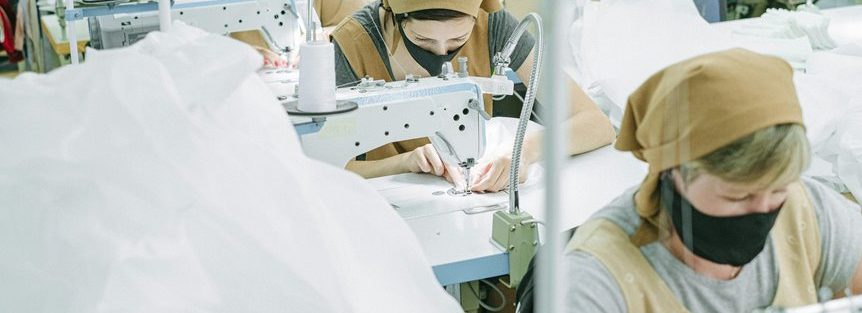At Novatia Consulting, we offer essential feasibility study services tailored for the textile and garment manufacturing sector in Nigeria. Our approach assesses market demand, resource management, and competitive landscape to guarantee thorough insights into project viability. We consider sustainability and technology integration as core components to improve efficiency and compliance. Our strategic recommendations and risk assessments guide businesses towards informed decision-making and long-term success. By understanding the unique market dynamics, we position you for growth in this evolving industry. As we explore further, you'll uncover more about how we can support your initiatives effectively.
Key Takeaways
- Novatia Consulting offers comprehensive feasibility studies tailored to evaluate textile and garment manufacturing projects in Nigeria.
- Their services assess market demand, operational costs, and resource availability for informed decision-making.
- The firm emphasizes sustainability practices, ensuring compliance with environmental regulations and eco-friendly materials.
- Novatia Consulting integrates technology analysis to enhance production efficiency and product quality in the textile sector.
- Their expertise includes navigating regulatory compliance and risk management to support successful project implementation in Nigeria's textile industry.
Overview of Feasibility Studies
Conducting a feasibility study is fundamental for understanding the viability of any project, including textile and garment manufacturing in Nigeria. It allows us to systematically assess the market, operational processes, and financial implications before committing significant resources. When we investigate this study, we focus on critical factors such as sustainability practices and technology integration, which are increasingly essential in today's manufacturing landscape.
By examining sustainability practices, we can identify ways to minimize environmental impact while enhancing brand value. This not only corresponds with global trends but also appeals to eco-conscious consumers. In addition, integrating advanced technology into our manufacturing processes can optimize efficiency, reduce costs, and improve product quality.
In our analysis, we also consider the local context, such as available resources, labor, and infrastructure. This all-encompassing approach guarantees that we fully understand potential challenges and opportunities, allowing us to make informed decisions. Ultimately, a well-conducted feasibility study will provide us with a clear roadmap for successful textile and garment manufacturing in Nigeria, balancing profitability with sustainable growth. By strategically addressing these elements, we can position ourselves for long-term success in this competitive industry.
Importance of Feasibility Studies
Understanding the significance of feasibility studies is key to maneuvering the complexities of textile and garment manufacturing in Nigeria. These studies serve as a strategic tool, enabling us to appraise potential projects before committing resources. By evaluating critical factors like market demand, resource availability, and operational costs, we can make informed decisions that coincide with our business objectives.
Moreover, feasibility studies play an essential role in integrating sustainability practices into our manufacturing processes. They allow us to identify eco-friendly materials and methods that not only improve our brand image but also comply with increasingly stringent environmental regulations. This approach not only benefits our planet but can also lead to cost savings in the long run.
In addition, technology integration is another significant aspect that feasibility studies address. By analyzing the latest advancements in manufacturing technology, we can determine which tools and systems will optimize our production processes and enhance efficiency. This strategic foresight guarantees that we stay competitive in a rapidly evolving industry.
In essence, feasibility studies enable us to traverse the textile and garment landscape in Nigeria with confidence, guaranteeing our initiatives are sustainable, innovative, and ultimately successful.
Market Analysis in Textile Industry
Analyzing the textile market in Nigeria reveals a landscape rich with opportunities and challenges that demand our attention. As we explore consumer preferences, we notice a shift towards sustainable and ethically produced fabrics, reflecting global market trends. This growing consciousness requires us to adopt sustainability practices to appeal to environmentally aware consumers.
Our pricing strategies must be competitive yet reflective of quality, as many local brands vie for market share. Understanding distribution channels is essential; leveraging both traditional and modern retail avenues can improve our reach. Furthermore, technology adoption is increasingly significant for streamlining operations and improving product quality, enabling us to stay ahead in a fast-evolving market.
Additionally, we should explore export opportunities, particularly in neighboring West African markets where demand for Nigerian textiles is rising. Establishing local partnerships can bolster our supply chain, improve resources, and foster innovation, ultimately positioning us to capitalize on these opportunities. By strategically addressing these elements, we can maneuver through the complexities of Nigeria's textile industry and pave the way for sustainable growth.
Competitive Landscape Assessment
In the dynamic arena of Nigeria's textile industry, the competitive landscape presents both formidable challenges and significant opportunities for our venture. A thorough competitor analysis reveals varying pricing strategies and brand positioning that influence market trends. By understanding these dynamics, we can identify gaps in the market that allow us to tailor our offerings effectively.
We must pay close attention to consumer preferences, as they're evolving towards sustainable and ethically produced textiles. This shift not only impacts our product development but also necessitates the adoption of technology to streamline our supply chain and improve operational efficiency. Competitors who embrace sustainability practices are gaining traction, highlighting the need for us to adjust our strategies accordingly.
Moreover, leveraging technology can set us apart in the market. By integrating innovative solutions, we can optimize production processes and respond quickly to changing consumer demands. To summarize, traversing the competitive landscape in Nigeria's textile industry requires a strategic focus on competitor analysis, pricing strategies, and sustainability practices while being attuned to market trends and consumer preferences. This approach will position us favorably as we commence our venture.
Resource Availability and Management
Amidst Nigeria's rich tapestry of natural resources, the availability and strategic management of these assets are fundamental for our textile and garment manufacturing venture. To succeed, we must focus on optimizing our supply chain to guarantee a steady flow of raw materials, which are pivotal for production. Effective resource allocation will allow us to balance labor resources and raw material sourcing, enhancing both efficiency and productivity.
Integrating technology into our operations will not only streamline processes but also contribute to environmental sustainability. By adopting innovative practices, we can minimize waste and reduce our carbon footprint, synchronizing with global environmental standards. Additionally, investing in skill development is essential; a skilled workforce is key to maintaining quality and improving output.
Cost management strategies will play a significant role in our overall success. By closely monitoring expenses related to labor and materials, we can secure profitability. In conclusion, a thorough approach to resource availability and management—encompassing supply chain optimization, technology integration, and skill development—will position us for sustainable growth in Nigeria's textile and garment industry. Together, we can harness these resources effectively to achieve our strategic objectives.
Financial Projections and Budgeting
Effective financial projections and budgeting are essential for the success of our textile and garment manufacturing venture in Nigeria. By conducting a thorough cost analysis, we can identify all necessary expenditures, ensuring our expense management strategies are robust. Accurate revenue forecasting will allow us to estimate potential earnings, which is critical for determining our profit margins.
To secure the necessary capital, we need to develop strategic funding strategies that correspond with our financial goals. This involves evaluating various funding sources, from loans to investors, all while keeping an eye on potential investment returns.
Moreover, ensuring financial sustainability will require us to maintain positive cash flow. We must monitor our incoming and outgoing funds diligently, allowing us to adapt to market fluctuations and unexpected costs. By crafting realistic financial projections, we can anticipate challenges and set appropriate financial standards.
Regulatory Requirements in Nigeria
Maneuvering the regulatory landscape in Nigeria is crucial for our textile and garment manufacturing initiative. We must understand the compliance challenges that can arise from the country's complex licensing procedures. Securing the necessary permits is a critical first step, as each license can dictate operational capabilities and market access.
Moreover, we need to stay informed about environmental regulations that govern waste disposal and resource usage. Adhering to these standards not only reduces legal risks but also improves our brand image. Labor laws are another crucial area; we must guarantee fair treatment and safe working conditions for our employees to avoid penalties and foster a productive workplace.
Taxation policies can greatly impact our profit margins, so we should strategize to optimize our tax obligations while remaining compliant. Import restrictions may affect our supply chain, thereby necessitating careful planning to avoid disruptions. Finally, meeting quality standards and safety regulations is non-negotiable; they protect our consumers and uphold our reputation.
Production Capacity Evaluation
Understanding regulatory requirements sets the stage for evaluating our production capacity in Nigeria. By examining our current capabilities, we can identify areas for improvement and guarantee compliance with industry standards. We need to look closely at our production efficiency, focusing on how well we're utilizing resources, labor, and technology.
Through this evaluation, we can uncover potential bottlenecks that hinder output and quality. It's essential to gather data on our existing processes, analyzing everything from material sourcing to manufacturing workflows. By doing so, we can pinpoint inefficiencies and develop strategies for capacity optimization.
Moreover, we should consider the scalability of our operations. Are we equipped to meet increasing demands? By projecting future trends in the textile and garment market, we can coordinate our production capacity with anticipated shifts.
In essence, this evaluation isn't just about numbers; it's about crafting a strategic roadmap that improves our operational capabilities. Together, we can guarantee that our production capacity not only meets current needs but also positions us for sustainable growth in Nigeria's vibrant textile industry.
Risk Assessment and Mitigation
In the intricate landscape of textile and garment manufacturing, risk assessment and alleviation are essential for ensuring our operational resilience. We need to recognize that various operational challenges can arise, impacting our supply chain and overall productivity. A thorough risk management strategy must include financial risks linked to market fluctuations, which can jeopardize our profitability.
To steer through these complexities, crisis planning becomes invaluable. By anticipating potential disruptions, we can develop contingency plans that safeguard our operations. Additionally, maintaining stringent quality control processes is essential to lessen compliance issues that could arise from regulatory changes or production errors.
Stakeholder involvement is another important component of our risk assessment framework. By involving key stakeholders in our decision-making processes, we can improve our understanding of the risks we face and foster a collaborative approach to overcoming them.
Lastly, technology adoption plays a significant role in improving our resilience. Embracing innovative solutions can streamline operations, boost data accuracy, and ultimately minimize risks associated with both supply chain disruptions and operational inefficiencies. In conclusion, a proactive approach to risk assessment and alleviation is critical for our success in the textile and garment sector.
Strategic Recommendations
To thrive in the competitive textile and garment manufacturing landscape, we must adopt strategic recommendations that boost our operational effectiveness and market positioning. First, integrating advanced technology into our production processes can improve efficiency and reduce waste, coordinating with sustainability practices that are increasingly important to consumers.
We should prioritize workforce training to equip our employees with the skills necessary to adapt to new technologies and evolving market demands. This investment in human capital will not only enhance productivity but also foster innovation within our teams.
Moreover, optimizing our supply chain will enable us to respond swiftly to consumer trends and demand fluctuations. By establishing local partnerships, we can strengthen our supply chains and support community development, improving our brand's reputation.
Additionally, we need to refine our branding strategies to resonate with both domestic and international markets, capitalizing on export opportunities that arise from our unique offerings. By ensuring our products reflect quality and sustainability, we can set ourselves apart from competitors and build strong customer loyalty. Together, these strategic recommendations will position us for success in Nigeria's textile and garment manufacturing sector.
Case Studies and Success Stories
Over the past decade, several successful textile and garment manufacturing ventures in Nigeria have demonstrated the potential for growth in this sector. One notable example is a local brand that integrated advanced technology into its production processes, markedly enhancing efficiency and output. By utilizing automated cutting machines and digital printing, they not only reduced waste but also improved the quality of their products.
Moreover, this brand adopted sustainable practices, sourcing organic materials and implementing eco-friendly dyeing processes. Their commitment to sustainability resonated with consumers, increasing brand loyalty and market share.
Another case is a cooperative that focused on enabling local artisans. By providing training on modern manufacturing techniques and promoting technology integration, they transformed traditional skills into competitive advantages. This approach not only preserved cultural heritage but also created job opportunities within the community.
These success stories illustrate that when businesses embrace sustainable practices and leverage technology, they can thrive in Nigeria's textile and garment industry. As we analyze these cases, it's clear that strategic planning and innovation are key drivers for achieving long-term success in this promising sector.
Next Steps for Entrepreneurs
Building on the insights from successful ventures in Nigeria's textile and garment sector, it's clear that aspiring entrepreneurs have a roadmap to follow. First, we need to focus on thorough business planning. This involves defining our business model, identifying target markets, and outlining our production processes. A well-structured business plan not only guides our operations but also serves as a valuable tool for attracting investors.
Next, we must explore various funding strategies. In Nigeria, there are numerous avenues we can pursue, including government grants, loans from financial institutions, and private investors. By presenting a solid business plan, we can effectively communicate our vision and attract the necessary funds to launch and scale our enterprises.
Additionally, networking within the industry is essential. By connecting with established players, we can gain insights, forge partnerships, and access resources that may not be readily available. Finally, we should continuously monitor market trends and adapt our strategies accordingly. This proactive approach will enable us to not only survive but thrive in the competitive textile and garment market. Together, we can turn our entrepreneurial dreams into a successful reality.
Frequently Asked Questions
What Qualifications Do Novatia Consulting's Experts Have in Textile Manufacturing?
When we consider qualifications in textile manufacturing, we look for a blend of textile expertise and practical experience. Our team combines academic backgrounds in textile engineering with years of hands-on manufacturing insights. We've worked on numerous projects that required strategic planning and deep industry knowledge. This unique combination allows us to provide informed recommendations, ensuring that our clients can maneuver the complexities of textile manufacturing with confidence and success.
How Long Does a Typical Feasibility Study Take to Complete?
When we consider a typical feasibility study, we find that the feasibility timeline usually spans several weeks to a few months. It's vital for us to guarantee study efficiency throughout this process. By strategically analyzing market conditions, operational requirements, and financial viability, we can provide an extensive assessment. This timeframe allows us to gather essential data, involve stakeholders, and deliver actionable insights that guide informed decision-making for any project we undertake.
What Is the Cost Range for Novatia Consulting's Services?
When we consider service pricing for feasibility studies, it often varies based on project scope and complexity. Typically, we can expect costs to range considerably depending on specific requirements and deliverables. It's crucial to assess what each project entails, as this will guide the overall budget. By analyzing our needs and harmonizing them with strategic objectives, we can guarantee we're investing wisely in the right services for successful outcomes.
Are There Any Specific Funding Options Available for Textile Startups in Nigeria?
When considering funding options for textile startups in Nigeria, we've found that government grants are a viable source for initial capital. These grants often aim to boost local industries. Additionally, tapping into private investors can provide not just funds but valuable industry connections. By strategically combining these resources, we can improve our startup's potential for success. It's essential to research and harmonize our business goals with the right funding sources.
Can Novatia Assist With Post-Feasibility Study Implementation Support?
Absolutely, we can assist with post-feasibility study implementation support. Our expertise lies in developing tailored implementation strategies that correspond with your goals. We recognize that effective project management is vital to guarantee smooth execution and maximize results. By collaborating closely with you, we'll guide you through each phase, addressing challenges and optimizing resources, securing your project not only starts strong but also maintains momentum for long-term success. Let's make it happen together!







